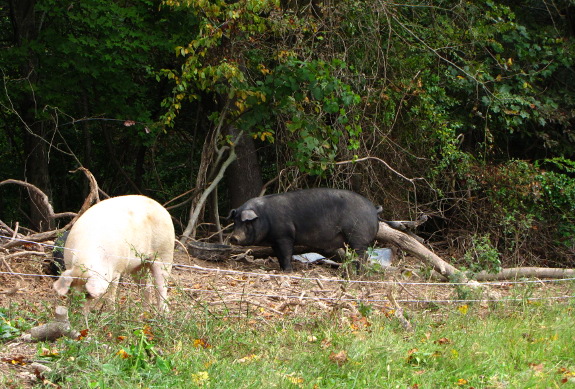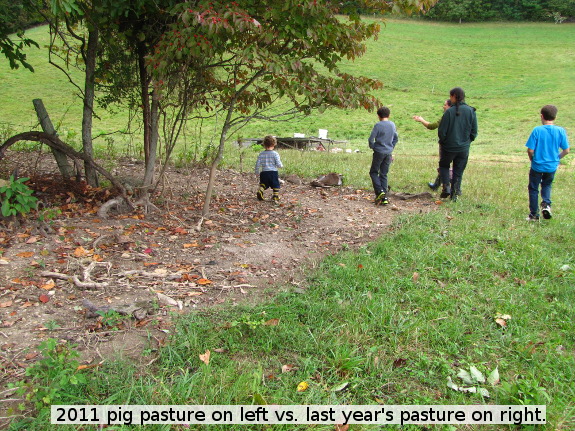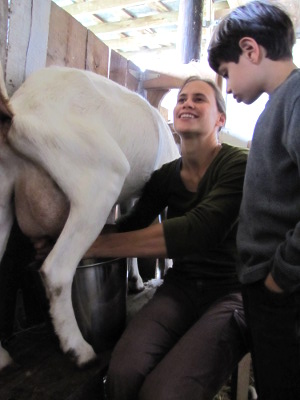
Colonizing livestock: Pigs and goats

Although Megan didn't
explain it this way, I divide her livestock up into two categories ---
the colonizers and the maintainers. Today, I'll discuss the
colonizers, which are animals she and her husband turn into areas that
have become overgrown with troublesome weeds or turn into woodland
that's destined to be pasture.
Joel Salatin uses pigs extensively as
colonizers, and Megan's four pigs certainly had a huge impact on their
pasture in very little time. Unless you put a ring in a pig's
nose (did you know that's why pigs sometimes wear rings?), the pig's
favorite method of feeding is to snuffle through the dirt and find
tasty tubers and roots to eat. You can think of pigs as plows,
with all of the pros and cons that comparison entails. Both plows
and pigs will reduce weed pressure immensely and let you start at
ground zero --- whether you want to start there is up to you.

Of course, you don't
have to let your pigs graze all the way down to bare earth, and I don't
think Megan and Erek actually intended that to happen. At this
time of year, there are so many parts of a farm where you just have to
throw up your hands and say "The animals have food and water.
Everything else can wait until next year!" I suspect moving the
pigs to a new pasture was a bit like our vastly overgrown blueberry
patch --- just too much to handle at this instant. I'll talk more
about rotating animals later, but I should mention here that Joel
Salatin uses 30 to 50 pigs in eight paddocks per acre to kill off the
perennial weeds while maintaining a ground cover of pasture
plants. Each pig paddock is only grazed three times per year, and
the pigs are never allowed on pasture in the winter since they'll churn
the ground up to mud.
 Goats are a less
destructive (but slower) colonizer species. They function more
like repeated bushhogging, eating the aboveground portions of tall
weeds, vines, and small trees constantly until the unwanted plants give
up the ghost. Salatin doesn't use goats in his system because he
didn't have a market for their meat and milk, but to my halfway
educated eye, goats seem friendlier to the earth. On the other
hand, goats need better fences than pigs and are more appropriate to
smaller operations where you can put more time into each animal.
Goats are a less
destructive (but slower) colonizer species. They function more
like repeated bushhogging, eating the aboveground portions of tall
weeds, vines, and small trees constantly until the unwanted plants give
up the ghost. Salatin doesn't use goats in his system because he
didn't have a market for their meat and milk, but to my halfway
educated eye, goats seem friendlier to the earth. On the other
hand, goats need better fences than pigs and are more appropriate to
smaller operations where you can put more time into each animal.
In either case, goats or
pigs are used in a paddock for only a short time, then are moved on to
the next trouble spot. Megan walked me through last year's pig
paddock, which now looks like a nice grassy pasture with just a few
small patches of poison ivy. The whole thing had been chock full
of the troublesome vine before her pigs went to work, so Megan gives
her pigs high marks for dealing with poison ivy.
Once the colonizers have
done their work, the pasture is ready to be used by the maintainers ---
the subject of tomorrow's post.
| This post is part of our Salatin-style Pasturing lunchtime series.
Read all of the entries: |
Want more in-depth information? Browse through our books.
Or explore more posts by date or by subject.
About us: Anna Hess and Mark Hamilton spent over a decade living self-sufficiently in the mountains of Virginia before moving north to start over from scratch in the foothills of Ohio. They've experimented with permaculture, no-till gardening, trailersteading, home-based microbusinesses and much more, writing about their adventures in both blogs and books.
Want to be notified when new comments are posted on this page? Click on the RSS button after you add a comment to subscribe to the comment feed, or simply check the box beside "email replies to me" while writing your comment.

So two thoughts - first our former CSA in the greater DC area would raise one or two baby pigs each summer season and built runs along one or two long sides of the main market garden area. He had found that deer would not jump through the pig pen to get to the vegetables.
second, what about geese as colonizing poultry?
Your pig deer deterrents sounds like our chicken moat. I think that any linear pasture around the garden perimeter works to deter deer, regardless of the kind of livestock involved.
I have to admit that I don't know all that much about geese, but I would have thought they would have been maintainer livestock. I've never considered geese or ducks very utilitarian --- all of the bloggers who raise them seem to report that they don't lay all that much and that they're very tough to pluck, so they tend to turn into pets....